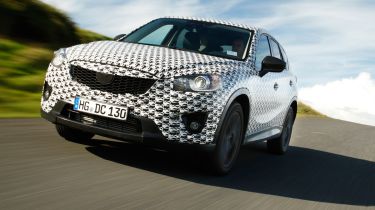Mazda CX-5
Early verdict on Mazda's efficient new Skoda Yeti rival

If you need proof that the basic design of a 4x4 has changed beyond recognition, look no further than the Mazda CX-5. It’s light and fuel efficient – plus, surprisingly, of the two transmissions we drove, the front-wheel-drive version is better. With lots of space and generous equipment inside, plus low CO2 emissions, we reckon that this is the most appealing Mazda we have driven this year.
Ignore the chequered disguise on this prototype. Under the black and white paintwork is Mazda’s all-new answer to the likes of the Skoda Yeti and Volkswagen Tiguan – and Auto Express has driven it first.
The CX-5 is the same size as the Land Rover Freelander, and is the first model to feature all of Mazda’s Skyactiv fuel-saving technologies. Bosses promise this will give it the potential to reduce consumption by up to 30 per cent.
On sale next March, the model is in the last stages of development, hence the unusual paint scheme. Prices are still to be confirmed, but are expected to start at around £25,000.
Even camouflaged, it looks stylish, and from behind the wheel, the CX-5 provides a commanding view of the road ahead. What’s more, the interior is neatly designed and packed with hi-tech extras, such as a touchscreen navigation system. The seats offer a good blend of comfort and support, and there’s plenty of passenger space, particularly in the rear.
Although the car is still a work in progress, it quickly proves to be great to drive. Thanks to the use of high-tensile steels in the body, weight is reduced without compromising toughness. New suspension means the car rides over imperfections in the road smoothly, and the steering is responsive. A short-throw gearlever, developed to feel like the one fitted to the MX-5, adds to the sporty theme.
We drove six prototypes in all, fitted with the company’s new 173bhp 2.2-litre diesel or 164bhp 2.0-litre petrol powerplant. We tried front and four wheel-drive versions, with two new gearboxes: a six-speed manual and automatic.
Although no official fuel consumption figures are available, both engines underlined their potential. On our route, the manual diesel returned 50mpg at a constant 60mph.
The petrol unit delivered around 45mpg at the same speed, but expect these figures to drop slightly around town. The front-wheel-drive petrol version is better to drive. It’s light, agile and responsive. Ultimately, though, the new diesel engine is the star of the show.
Revving to nearly 5,500rpm, it offers the performance and refinement to rival a petrol unit. Rarely has a new car looked so promising.







